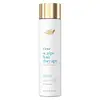What's inside
What's inside
 Key Ingredients
Key Ingredients

No key ingredients
 Benefits
Benefits

 Concerns
Concerns

 Ingredients Side-by-side
Ingredients Side-by-side

Water
Skin ConditioningSodium C14-16 Olefin Sulfonate
CleansingCocamidopropyl Hydroxysultaine
CleansingPolyquaternium-7
Cocamide Mea
EmulsifyingPropanediol
SolventHydroxypropyltrimonium Honey
Acrylamidopropyltrimonium Chloride/Acrylamide Copolymer
Phenoxyethanol
PreservativeBenzoic Acid
MaskingEthylhexylglycerin
Skin ConditioningGlycereth-2 Cocoate
EmulsifyingGlycol Distearate
EmollientYogurt Powder
Citrus Aurantium Dulcis Peel Oil
MaskingParfum
MaskingWater, Sodium C14-16 Olefin Sulfonate, Cocamidopropyl Hydroxysultaine, Polyquaternium-7, Cocamide Mea, Propanediol, Hydroxypropyltrimonium Honey, Acrylamidopropyltrimonium Chloride/Acrylamide Copolymer, Phenoxyethanol, Benzoic Acid, Ethylhexylglycerin, Glycereth-2 Cocoate, Glycol Distearate, Yogurt Powder, Citrus Aurantium Dulcis Peel Oil, Parfum
Water
Skin ConditioningSodium C14-16 Olefin Sulfonate
CleansingCocamidopropyl Betaine
CleansingSodium Chloride
MaskingCocamidopropyl Hydroxysultaine
CleansingGlycerin
HumectantSodium Gluconate
Skin ConditioningNiacinamide
SmoothingHydrolyzed Yeast Protein
Skin ConditioningZinc Gluconate
Skin ConditioningTocopheryl Acetate
AntioxidantDimethiconol
EmollientCitric Acid
BufferingParfum
MaskingSodium Benzoate
MaskingCarbomer
Emulsion StabilisingPolyquaternium-7
Guar Hydroxypropyltrimonium Chloride
Skin ConditioningTea-Dodecylbenzenesulfonate
CleansingDisodium EDTA
PPG-9
Skin ConditioningPEG-45m
HumectantHexyl Cinnamal
PerfumingLimonene
PerfumingLinalool
PerfumingWater, Sodium C14-16 Olefin Sulfonate, Cocamidopropyl Betaine, Sodium Chloride, Cocamidopropyl Hydroxysultaine, Glycerin, Sodium Gluconate, Niacinamide, Hydrolyzed Yeast Protein, Zinc Gluconate, Tocopheryl Acetate, Dimethiconol, Citric Acid, Parfum, Sodium Benzoate, Carbomer, Polyquaternium-7, Guar Hydroxypropyltrimonium Chloride, Tea-Dodecylbenzenesulfonate, Disodium EDTA, PPG-9, PEG-45m, Hexyl Cinnamal, Limonene, Linalool
 Reviews
Reviews

Ingredients Explained
These ingredients are found in both products.
Ingredients higher up in an ingredient list are typically present in a larger amount.
Cocamidopropyl Hydroxysultaine is a synthetic cleansing agent, though it is derived from coconut oil.
It is used to enhance the texture of products by boosting lather and thickening the texture. As a cleanser, Cocamidopropyl Hydroxysultaine is mild.
Parfum is a catch-all term for an ingredient or more that is used to give a scent to products.
Also called "fragrance", this ingredient can be a blend of hundreds of chemicals or plant oils. This means every product with "fragrance" or "parfum" in the ingredients list is a different mixture.
For instance, Habanolide is a proprietary trade name for a specific aroma chemical. When used as a fragrance ingredient in cosmetics, most aroma chemicals fall under the broad labeling category of “FRAGRANCE” or “PARFUM” according to EU and US regulations.
The term 'parfum' or 'fragrance' is not regulated in many countries. In many cases, it is up to the brand to define this term.
For instance, many brands choose to label themselves as "fragrance-free" because they are not using synthetic fragrances. However, their products may still contain ingredients such as essential oils that are considered a fragrance by INCI standards.
One example is Calendula flower extract. Calendula is an essential oil that still imparts a scent or 'fragrance'.
Depending on the blend, the ingredients in the mixture can cause allergies and sensitivities on the skin. Some ingredients that are known EU allergens include linalool and citronellol.
Parfum can also be used to mask or cover an unpleasant scent.
The bottom line is: not all fragrances/parfum/ingredients are created equally. If you are worried about fragrances, we recommend taking a closer look at an ingredient. And of course, we always recommend speaking with a professional.
Learn more about ParfumPolyquaternium-7 is a light to clear colored liquid. It is commonly found in haircare products for its film-forming and anti-static properties.
According to a manufacturer, it is a non-paraben and specially developed for negatively charged surfactant systems. This makes it a great hairstyle holder and helps to improve wet hair detangling without adding buildup.
Sodium C14-16 Olefin Sulfonate is a cleansing agent made from a mixture of long chain sulfonate salts. It can also help produce foam.
This ingredient may be drying. We recommend speaking with a professional if you have concerns.
Water. It's the most common cosmetic ingredient of all. You'll usually see it at the top of ingredient lists, meaning that it makes up the largest part of the product.
So why is it so popular? Water most often acts as a solvent - this means that it helps dissolve other ingredients into the formulation.
You'll also recognize water as that liquid we all need to stay alive. If you see this, drink a glass of water. Stay hydrated!
Learn more about Water